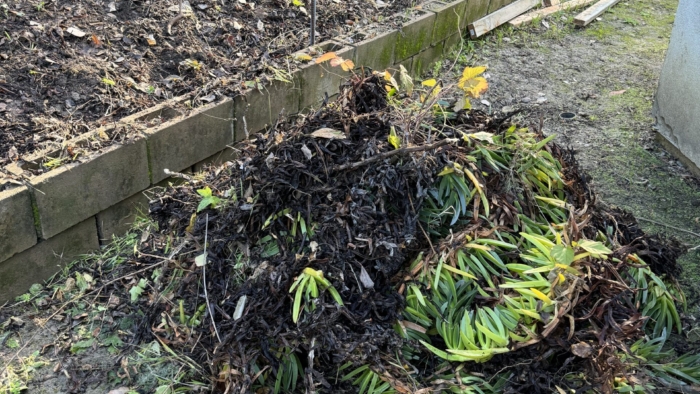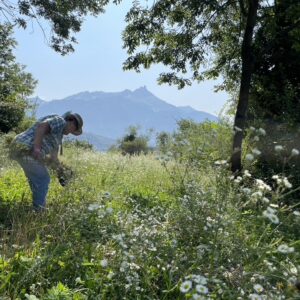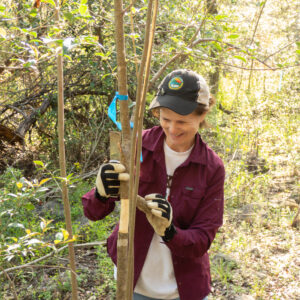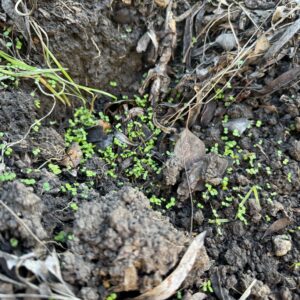“The kingdom of heaven is like a man who sowed good seed in his field; but while men slept, his enemy came and sowed tares among the wheat and went his way. But when the grain had sprouted and produced a crop, then the tares also appeared…” (Matthew 13:24-26)
Since moving to a new home, with my new husband, I’ve declared war. War on the invasive iceplant covering a hillside all along the property. This mounding succulent (Carpobrotus edulis) has spread aggressively across the Californian coast, choking out native vegetation and disrupting the composition of the soil. Native to South Africa, it was brought to the Golden State in the early 1900s to stabilize soil alongside railroad tracks and later highways.
As we can see from multi-million dollar homes crashing into the sea when it rains, as well as the ease with which I yank out iceplant on my property, it actually does an abysmal job at preventing erosion: heavy mats of the shallowly-rooted plants easily slide off steep surfaces, pulling soil down with it.
Working from home, I often have iceplant on the brain, and I habitually take breaks to fill up a bin with the pesky invader. At first, I thought I was hallucinating when on a Sunday morning my priest began discussing “invasive species” at the pulpit. The Gospel reading was Matthew 13, the story of the wheat and the tares. In the parable, the owner of farmland beset by vicious weeds instructs his servants to let both plants grow until the harvest, lest he accidentally pull out the desired wheat. Reflecting on this story, Father John described our sins as an invasive species that tangle around and cover our hearts.
A Rocha is no stranger to the gritty, tedious work of removing invasive plants. From Switzerland’s dry meadows, to the eucalypt open-forest in Australia, to the Bull Creek watershed in Texas, precious habitats are slowly being restored. It may seem counterintuitive to kill trees like privet in Texas or clear out attractive vines in Australia. However, when unchecked by any natural barriers, these non-native plants spread aggressively, displacing the native vegetation that other creatures depend on for food and habitat.
In Australia, with invasive vines removed from the forest floor, the nationally vulnerable Black-breasted Button-quail has returned to the park to feed and breed. In the spaces where A Rocha USA has girdled and removed privet, low-growing native species can once again see the sun and can thrive on the forest floor.
Throughout the Bible, what is happening on the land is often a mirror of the spiritual state of its inhabitants. In Genesis, when the earth was filled with violence and corruption, evildoers were met with an all-consuming flood. As the Israelites approached the promised land, they were warned that if they failed to keep God’s law, the land would “vomit you out” (Leviticus 20:22). Even now, “The whole creation has been groaning together,” waiting to be set free from its bondage to decay (Romans 8:22). Either through carelessness, hubris, or greed, humans have disrupted landscapes over and over again, leading to the death and even extinction of many creatures beloved by God.
Over the Lenten season, it feels fitting to do the physical work of restoring habitat alongside the spiritual work of detangling and casting away sin. Unlike our sins, though, invasive species are not inherently harmful. Like all of creation, they were made “very good” by God in relationship with the rest of their native ecosystem. In my enthusiasm, I realize that I have begun to demonize the iceplant, which I’m sure is both beautiful and beneficial when in the right place. In Texas, we are brainstorming creative ways to repurpose invasive plants, even as we remove them.
Many invasive species like the Black Mustard (Brassica nigra) and highway iceplant we have in California are edible! Approaching a global problem as complex as invasive species will require all of our creativity, from arts and crafts to cooking up new dishes like an iceplant jam. In my own yard, I can eat up the iceplant, while local birds, insects, reptiles, and other creatures will find food and habitat in the native plants that take its place.
So far, I have scattered wildflower seeds along the newly cleared hillslide. With an abundance of late-winter rains, a great deal are sprouting, but it’s hard to tell what is a wildflower and what is a weed. Like the parable, we shall wait and see. On the day of the “invasive species” homily at church, we sang the timely hymn “Father we thank thee who hast planted thy holy Name within our hearts.” In this spirit of thankfulness, may we all cultivate the name of Jesus in our hearts and persist patiently in the work we’ve set out to do.
As Earth Day approaches, consider restoring the habitat where you live! Removing invasive plants and replacing them with native species is a wonderful way to know our place better, create functioning ecosystems, and offer praise to our Creator who made the myriad of creatures we share a home with. To find resources and an enthusiastic gardening community, join our Love Your Place Program at https://loveyourplace.org/.
“Father, we thank thee who hast planted
Thy holy name within our hearts.
Knowledge and faith and life immortal
Jesus Thy Son to us imparts.
Thou, Lord, didst make all for Thy pleasure,
didst give man food for all his days,
giving in Christ the Bread eternal;
Thine is the pow’r, be Thine the praise.”
-Hymn based on the Didache, 2nd century. Translated by Fr. Bland Tucker













Add a Comment